As reviewers, we eagerly await our first look at new releases with the beginning of the new year. The reading of new releases we have been doing suggests that 2019 will be another terrific year for children’s and young adult literature in which readers of all ages can look forward to many great books from which to choose.
Ages 4–8
Hands Up! Breanna J. McDaniel. Ill. Shane W. Evans. 2019. Dial/Penguin.
 Breanna J. McDaniel follows a black girl as she grows from baby to teenager, describing the many ways she and others raise their hands. Hands are raised by her parents playing peek-a-boo with her, and by her, as they help her get dressed in the morning. She raises her hands high when eager to answer a question in class and in taking a graceful ballet position. Hands are raised in praise by everyone while worshiping in church. Surrounded by friends picking grapes and apples, she declares, “We begin small, but we grow big. / Together we are mighty. / High fives all around, hands up!” The book ends with the girl joining a peaceful protest march. “As one we say, ‘HANDS UP!’” Shane W. Evans’ sunny, textured illustrations, created digitally with mixed media, joyfully express the positive “hands up!” message of this book: Uplifted hands celebrate and support one another.
Breanna J. McDaniel follows a black girl as she grows from baby to teenager, describing the many ways she and others raise their hands. Hands are raised by her parents playing peek-a-boo with her, and by her, as they help her get dressed in the morning. She raises her hands high when eager to answer a question in class and in taking a graceful ballet position. Hands are raised in praise by everyone while worshiping in church. Surrounded by friends picking grapes and apples, she declares, “We begin small, but we grow big. / Together we are mighty. / High fives all around, hands up!” The book ends with the girl joining a peaceful protest march. “As one we say, ‘HANDS UP!’” Shane W. Evans’ sunny, textured illustrations, created digitally with mixed media, joyfully express the positive “hands up!” message of this book: Uplifted hands celebrate and support one another.
—NB
The Quiet Boat Ride: And Other Stories (Fox + Chick #2). Sergio Ruzzier. 2019. Chronicle.
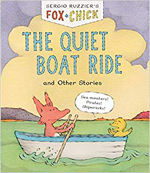 Young children will delight in joining Fox and Chick, best friends from Sergio Ruzzier’s The Party and Other Stories (2018), in three more mini-adventures. In “The Quiet Boat Ride,” Chick’s wild imagining of sea monsters, pirates, and shipwrecks makes Fox’s quiet boat ride on a pond very stressful. In “The Chocolate Cake,” Chick’s worries over the contents of a box he receives are put to rest by Fox, the giver of the gift. In “The Sunrise,” Fox agrees to let Chick join him to watch the sunrise from a hilltop but, when Chick’s preparation for the trip makes them miss the sunrise, the ever-resourceful Fox comes up with an alternative, watching sunset from the hilltop. Panels and double-page spreads with expressive ink and watercolor illustrations and a simple text presented entirely in dialogue balloons make this humorous comic-style picture book a good choice for newly independent readers.
Young children will delight in joining Fox and Chick, best friends from Sergio Ruzzier’s The Party and Other Stories (2018), in three more mini-adventures. In “The Quiet Boat Ride,” Chick’s wild imagining of sea monsters, pirates, and shipwrecks makes Fox’s quiet boat ride on a pond very stressful. In “The Chocolate Cake,” Chick’s worries over the contents of a box he receives are put to rest by Fox, the giver of the gift. In “The Sunrise,” Fox agrees to let Chick join him to watch the sunrise from a hilltop but, when Chick’s preparation for the trip makes them miss the sunrise, the ever-resourceful Fox comes up with an alternative, watching sunset from the hilltop. Panels and double-page spreads with expressive ink and watercolor illustrations and a simple text presented entirely in dialogue balloons make this humorous comic-style picture book a good choice for newly independent readers.
—CA
The Whole Wide World and Me. Toni July. 2019. Candlewick.
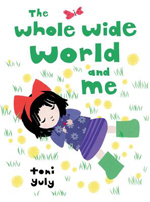 Toni July uses a simple, poetic text with only a few words on each double-page spread and illustrations (created with ink, charcoal pencil, torn tissue, cut paper, and digital collage) in a limited palette of bright colors to tell the story of a young girl’s busy day exploring the natural world. Her day begins with a walk through a field of flowers and ends with her back in the field examining a ladybird beetle and then sitting quietly on a large rock contemplating her place in the world. “I am a small / part of it all. / The whole wide world . . . / and me.” This cheerful picture book encourages young children to think about the wonders of the natural world and their relationship to it.
Toni July uses a simple, poetic text with only a few words on each double-page spread and illustrations (created with ink, charcoal pencil, torn tissue, cut paper, and digital collage) in a limited palette of bright colors to tell the story of a young girl’s busy day exploring the natural world. Her day begins with a walk through a field of flowers and ends with her back in the field examining a ladybird beetle and then sitting quietly on a large rock contemplating her place in the world. “I am a small / part of it all. / The whole wide world . . . / and me.” This cheerful picture book encourages young children to think about the wonders of the natural world and their relationship to it.
—CA
Ages 9–11
The Bridge Home. Padma Venkatraman. 2019. Nancy Paulsen/Penguin.
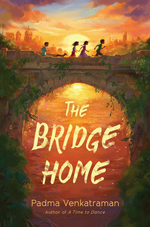 Eleven-year-old Viji and her sister with special needs, Rukku, flee their abusive father after he breaks their mother’s arm and physically hurts them. In the crowded city of Chennai, India, they find a community that befriends them (Teashop Aunty, puppy Kutti, homeless boys Muthu and Arul with whom they live under a bridge) and other unexpected allies. Surrounded by overwhelming poverty and dangerous strangers who steal from them, the girls survive, one day at a time. After Rukku dies from dengue fever, Celina Aunty, from the Safe Home for Working Children, directs guilt-ridden Viji to write letters to her sister to process what has happened. Back matter includes a glossary of Indian words used in the novel and an author’s note about the plight of homeless children in India.
Eleven-year-old Viji and her sister with special needs, Rukku, flee their abusive father after he breaks their mother’s arm and physically hurts them. In the crowded city of Chennai, India, they find a community that befriends them (Teashop Aunty, puppy Kutti, homeless boys Muthu and Arul with whom they live under a bridge) and other unexpected allies. Surrounded by overwhelming poverty and dangerous strangers who steal from them, the girls survive, one day at a time. After Rukku dies from dengue fever, Celina Aunty, from the Safe Home for Working Children, directs guilt-ridden Viji to write letters to her sister to process what has happened. Back matter includes a glossary of Indian words used in the novel and an author’s note about the plight of homeless children in India.
—NB
The End of the World and Beyond: Continues the Unexpected Life of Oliver Cromwell Pitt: Being an Absolutely Accurate Autobiographical Account of My Follies, Fortune & Fate Written by Himself. Avi. 2019. Algonquin.
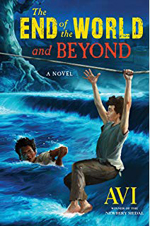 In this companion to The Unexpected Life of Oliver Cromwell Pitts (2017), 12-year-old Oliver continues the account of his unexpected life as he escapes the hangman’s noose for stealing 23 shillings only to be transported by convict ship from England to the American colonies, in 1725. Surviving the horrors of the perilous journey across a stormy Atlantic, he is sold in Annapolis, Maryland, as an indentured servant to Fitzhugh, a hard-drinking, brutal master, to labor on his small, isolated tobacco farm for a term of seven years. With hope for freedom, Oliver and Bara, a young slave, take to the dangerous swamp pursued by Fitzhugh, knowing that capture would mean death. The final chapter, “In Which My Life Has Even More Unexpected Events,” ends with Oliver putting down his pen, hoping his life is done with the unexpected and wondering whether Bara is also free.
In this companion to The Unexpected Life of Oliver Cromwell Pitts (2017), 12-year-old Oliver continues the account of his unexpected life as he escapes the hangman’s noose for stealing 23 shillings only to be transported by convict ship from England to the American colonies, in 1725. Surviving the horrors of the perilous journey across a stormy Atlantic, he is sold in Annapolis, Maryland, as an indentured servant to Fitzhugh, a hard-drinking, brutal master, to labor on his small, isolated tobacco farm for a term of seven years. With hope for freedom, Oliver and Bara, a young slave, take to the dangerous swamp pursued by Fitzhugh, knowing that capture would mean death. The final chapter, “In Which My Life Has Even More Unexpected Events,” ends with Oliver putting down his pen, hoping his life is done with the unexpected and wondering whether Bara is also free.
—CA
What is Poetry?: The Essential Guide to Reading and Writing Poems. Michael Rosen. 2019. Candlewick.
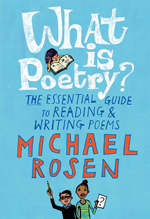 In this helpful guide, Michael Rosen reflects on his many years of writing poetry as he encourages his audience to “read, write, and listen to poetry.” Opening withthe titular question, he discusses and gives examples on a variety of topics such as how poetry suggests things (“A Word is Dead” by Emily Dickinson) or plays with words (“Waltzing Matilda” by Banjo Paterson). In subsequent chapters, Rosen writes about his composition process, ideas for poems (including performance art), and writing tips. By the final chapter, readers should have developed their own responses to the opening question and feel prepared to read more poetry and write their own verses. Back matter includes an appendix with sites about poetry and videos of poets performing, as well as a topical index.
In this helpful guide, Michael Rosen reflects on his many years of writing poetry as he encourages his audience to “read, write, and listen to poetry.” Opening withthe titular question, he discusses and gives examples on a variety of topics such as how poetry suggests things (“A Word is Dead” by Emily Dickinson) or plays with words (“Waltzing Matilda” by Banjo Paterson). In subsequent chapters, Rosen writes about his composition process, ideas for poems (including performance art), and writing tips. By the final chapter, readers should have developed their own responses to the opening question and feel prepared to read more poetry and write their own verses. Back matter includes an appendix with sites about poetry and videos of poets performing, as well as a topical index.
—NB
Ages 12–14
Cicada. Shaun Tan. 2019. Arthur A. Levine/Scholastic.
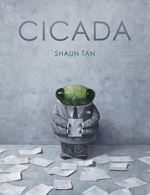 “Cicada work in tall building. / Data entry clerk. Seventeen year. / No sick day. No mistake. / Tok Tok Tok!” Through simple, rhythmic text paired with expressive, beautifully composed oil paintings on facing pages, Shaun Tan lets Cicada tell his story of diligently working with humans in a depressingly grey office cubicle, unaccepted and bullied by his human coworkers and unappreciated by his employees. Retiring after 17 years without promotion and benefits, Cicada makes his way to the rooftop of the tall building. “Time to say goodbye.” Readers will be startled by the ending of five wordless double-spread illustrations and a final four lines of text. Cicada is another timely, thought-provoking tale from master storyteller Tan. Be prepared to be surprised.
“Cicada work in tall building. / Data entry clerk. Seventeen year. / No sick day. No mistake. / Tok Tok Tok!” Through simple, rhythmic text paired with expressive, beautifully composed oil paintings on facing pages, Shaun Tan lets Cicada tell his story of diligently working with humans in a depressingly grey office cubicle, unaccepted and bullied by his human coworkers and unappreciated by his employees. Retiring after 17 years without promotion and benefits, Cicada makes his way to the rooftop of the tall building. “Time to say goodbye.” Readers will be startled by the ending of five wordless double-spread illustrations and a final four lines of text. Cicada is another timely, thought-provoking tale from master storyteller Tan. Be prepared to be surprised.
—CA
Dragon Pearl. Yoon Ha Lee. 2019. Rick Riordan Presents/Hyperion.
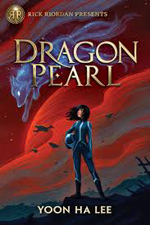 Thirteen-year-old Min, a shape-shifting fox spirit, leaves Jinju, the poor, undeveloped Thousand Worlds planet on which she lives in a human form, in search of her older brother Jun, a Space Forces cadet suspected of having deserted to search for the legendary mystical Dragon Pearl. She eventually lands on the Pale Lightning, her brother’s battle cruiser, having taken the shape of Bae Jang, a cadet who died at the hands of mercenaries while defending a space freighter, after promising his ghost that she’ll avenge his death. Befriended by two of Bae Jang’s friends, Cadet Haneul (a female dragon) and Cadet Sujin (a nonbinary goblin), she gathers information and develops the technical skills needed to pull off a dangerous plan to journey to the Ghost Sector, the location of the Dragon Pearl, where she hopes to find Jun. Yoon Ha Lee’s sci-fi thriller is an action-packed adventure story enriched with elements of Korean mythology.
Thirteen-year-old Min, a shape-shifting fox spirit, leaves Jinju, the poor, undeveloped Thousand Worlds planet on which she lives in a human form, in search of her older brother Jun, a Space Forces cadet suspected of having deserted to search for the legendary mystical Dragon Pearl. She eventually lands on the Pale Lightning, her brother’s battle cruiser, having taken the shape of Bae Jang, a cadet who died at the hands of mercenaries while defending a space freighter, after promising his ghost that she’ll avenge his death. Befriended by two of Bae Jang’s friends, Cadet Haneul (a female dragon) and Cadet Sujin (a nonbinary goblin), she gathers information and develops the technical skills needed to pull off a dangerous plan to journey to the Ghost Sector, the location of the Dragon Pearl, where she hopes to find Jun. Yoon Ha Lee’s sci-fi thriller is an action-packed adventure story enriched with elements of Korean mythology.
—CA
Ages 15+
Let’s Go Swimming on Doomsday. Natalie C. Anderson. 2019. Putnam/Penguin.
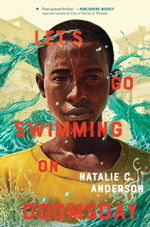 In this dark, political thriller, 16-year-old Abdiweli is forced by Mr. Jones of AMISOM (African Union Mission in Somalia) to become a soldier spy in the jihadi Somali militia, Al Shabaab (in which his older brother Dahir is a commander) in exchange for the promised return of his kidnapped family. After Dahir is injured and can’t carry out a suicide mission, Abdhi volunteers, but safely detonates the vest and defects. Shattered physically and mentally, he finds himself in Kenya with social worker Sam (a believer in Doomsday), who places “troublemaker” Abdi at the Maisha Girls Center where he conceals his identity and teaches fragile students to swim. Against all odds, Abdi eventually redeems himself and finds “a place of peace, a place like home.” Back matter includes an author’s note (on factual and fictional aspects of the story and her writing perspective) and a glossary of Somalian, Arabic, and Kiswahili words, initialisms, and acronyms.
In this dark, political thriller, 16-year-old Abdiweli is forced by Mr. Jones of AMISOM (African Union Mission in Somalia) to become a soldier spy in the jihadi Somali militia, Al Shabaab (in which his older brother Dahir is a commander) in exchange for the promised return of his kidnapped family. After Dahir is injured and can’t carry out a suicide mission, Abdhi volunteers, but safely detonates the vest and defects. Shattered physically and mentally, he finds himself in Kenya with social worker Sam (a believer in Doomsday), who places “troublemaker” Abdi at the Maisha Girls Center where he conceals his identity and teaches fragile students to swim. Against all odds, Abdi eventually redeems himself and finds “a place of peace, a place like home.” Back matter includes an author’s note (on factual and fictional aspects of the story and her writing perspective) and a glossary of Somalian, Arabic, and Kiswahili words, initialisms, and acronyms.
—NB
Shout: A Poetry Memoir. Laurie Halse Anderson. 2019. Viking/Penguin.
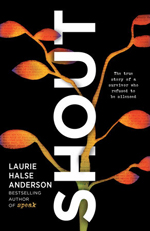 In 1999, author Laurie Halse Anderson wrote the multiple award-winning novel Speak, in which the protagonist is raped the summer before her freshman year of high school. On the 20th anniversary of Speak, Anderson, in her compellingly honest memoir-in-verse Shout, discloses circumstances of her complicated family dynamics growing up and her rape at age 13 with its emotional aftermath. In addition, her poems include the stories of others who have been violated, and she empowers readers as she throws down a gauntlet: “the consent of yes is necessary” and “ . . . When one / suffers, / all are weakened, / but when everyone thrives, we dance.” Back matter includes resources for readers.
In 1999, author Laurie Halse Anderson wrote the multiple award-winning novel Speak, in which the protagonist is raped the summer before her freshman year of high school. On the 20th anniversary of Speak, Anderson, in her compellingly honest memoir-in-verse Shout, discloses circumstances of her complicated family dynamics growing up and her rape at age 13 with its emotional aftermath. In addition, her poems include the stories of others who have been violated, and she empowers readers as she throws down a gauntlet: “the consent of yes is necessary” and “ . . . When one / suffers, / all are weakened, / but when everyone thrives, we dance.” Back matter includes resources for readers.
—NB
All Ages
I (HEART) Art: Art We Love from The Metropolitan Museum of Art. 2019. Abrams.
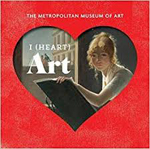 This small, chunky book is a child-friendly “catalog” of more than 150 works from the Metropolitan Museum of Art’s vast collection. The book is organized into 10 color-coded sections by theme: play; sports; music; singing and dancing; reading, writing, and drawing; animals; family; locomotion; the country; and the city. Each section begins with a five-line introduction. For example, the “I (HEART) Animals” section begins with “Who doesn’t (Heart) animals? / Grazing deer and growling tigers, / Leaping fish and splashing frogs, / Barking dogs and scrambling cats, / There are so many animals in the world!” As the introduction notes, I (HEART) Art is a book to come back to again and again because a work of art can have different meanings each time you look at it.
This small, chunky book is a child-friendly “catalog” of more than 150 works from the Metropolitan Museum of Art’s vast collection. The book is organized into 10 color-coded sections by theme: play; sports; music; singing and dancing; reading, writing, and drawing; animals; family; locomotion; the country; and the city. Each section begins with a five-line introduction. For example, the “I (HEART) Animals” section begins with “Who doesn’t (Heart) animals? / Grazing deer and growling tigers, / Leaping fish and splashing frogs, / Barking dogs and scrambling cats, / There are so many animals in the world!” As the introduction notes, I (HEART) Art is a book to come back to again and again because a work of art can have different meanings each time you look at it.
—CA
Nancy Brashear is Professor Emeritus of English, Azusa Pacific University, in Azusa, California. Carolyn Angus is former director of the George G. Stone Center for Children's Books, Claremont Graduate University, in Claremont, California.
These reviews are submitted by members of the International Literacy Association's Children's Literature and Reading Special Interest Group (CL/R SIG) and are published weekly on Literacy Daily.